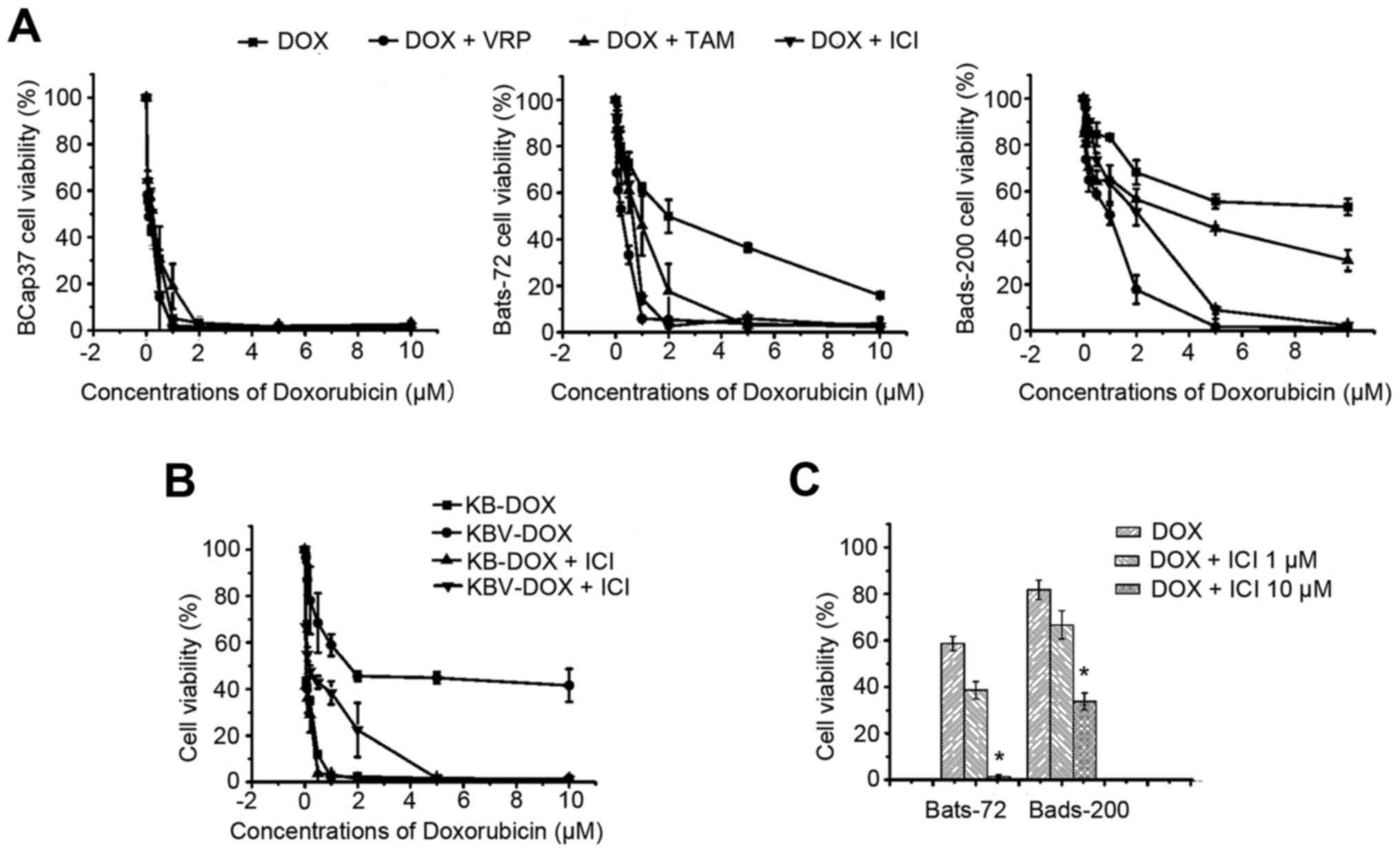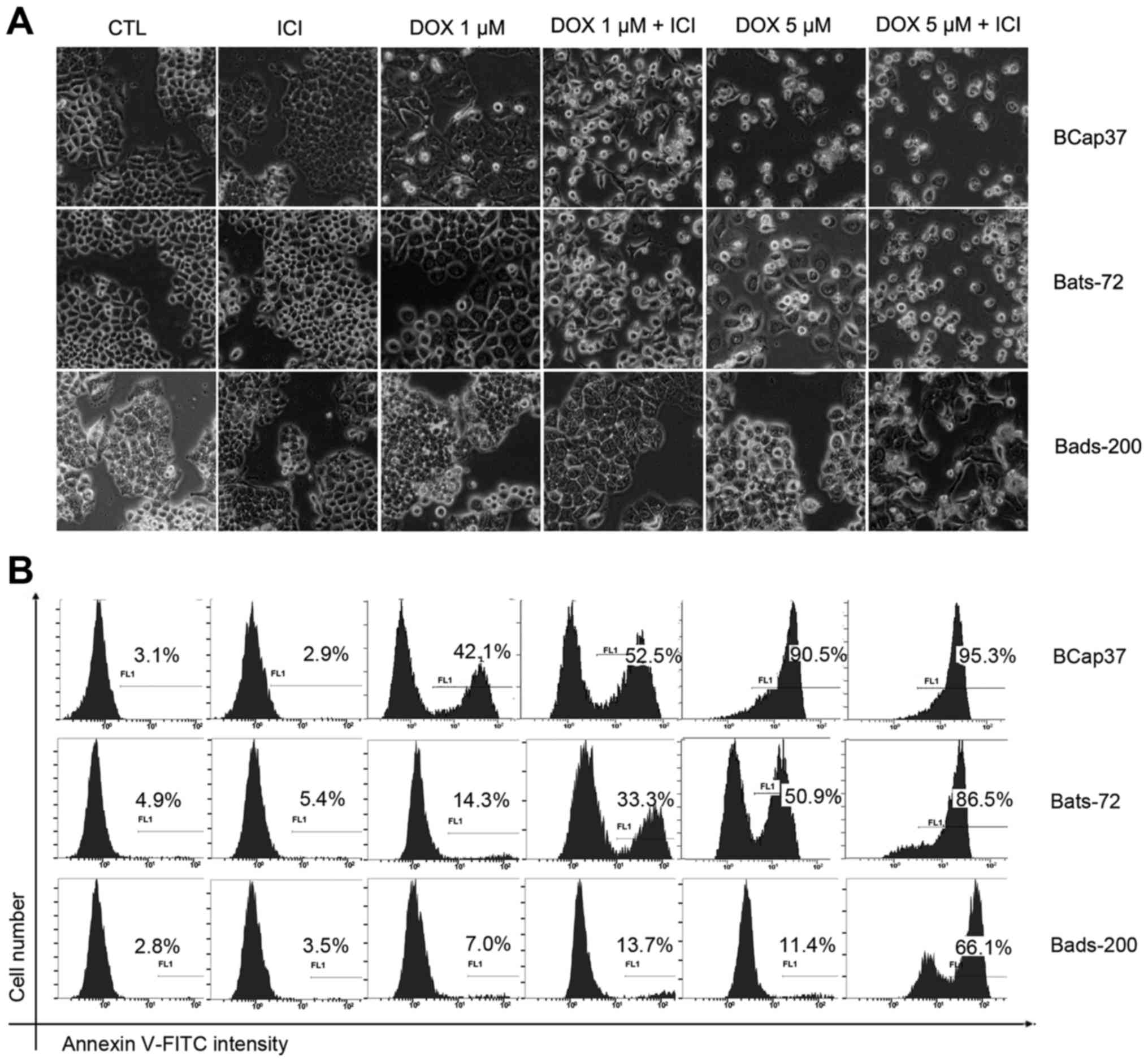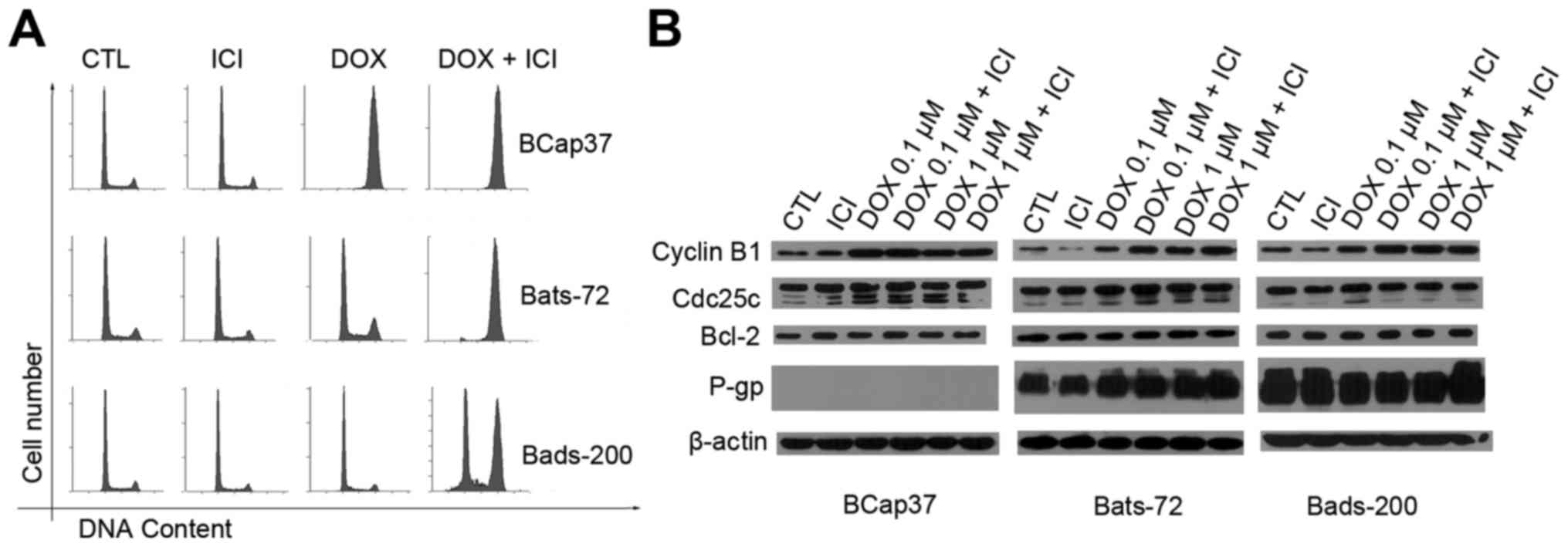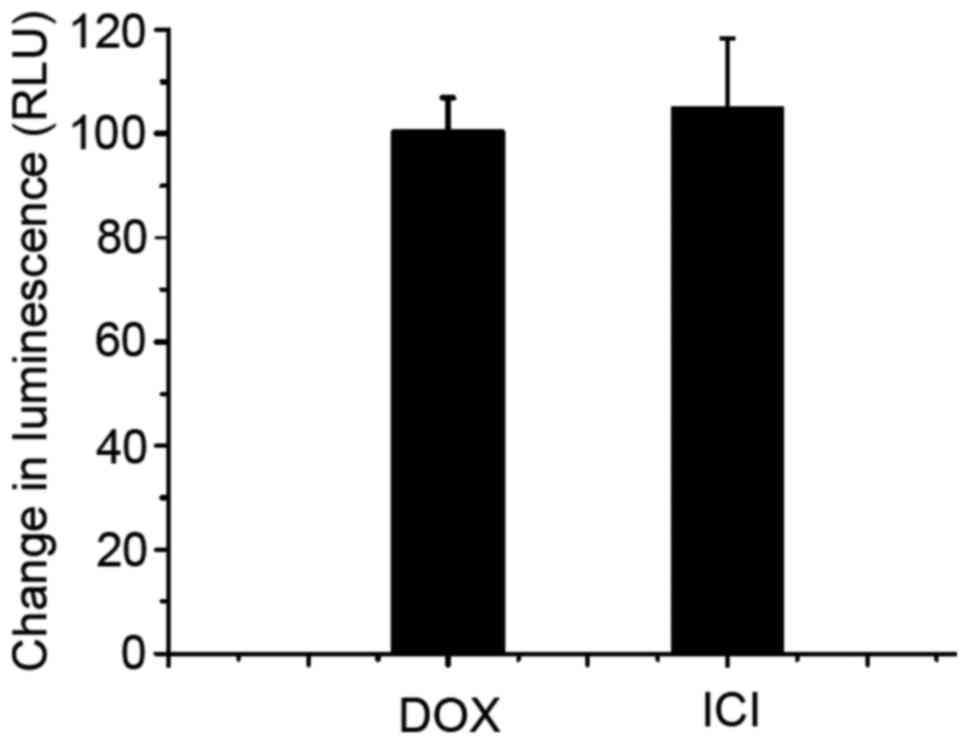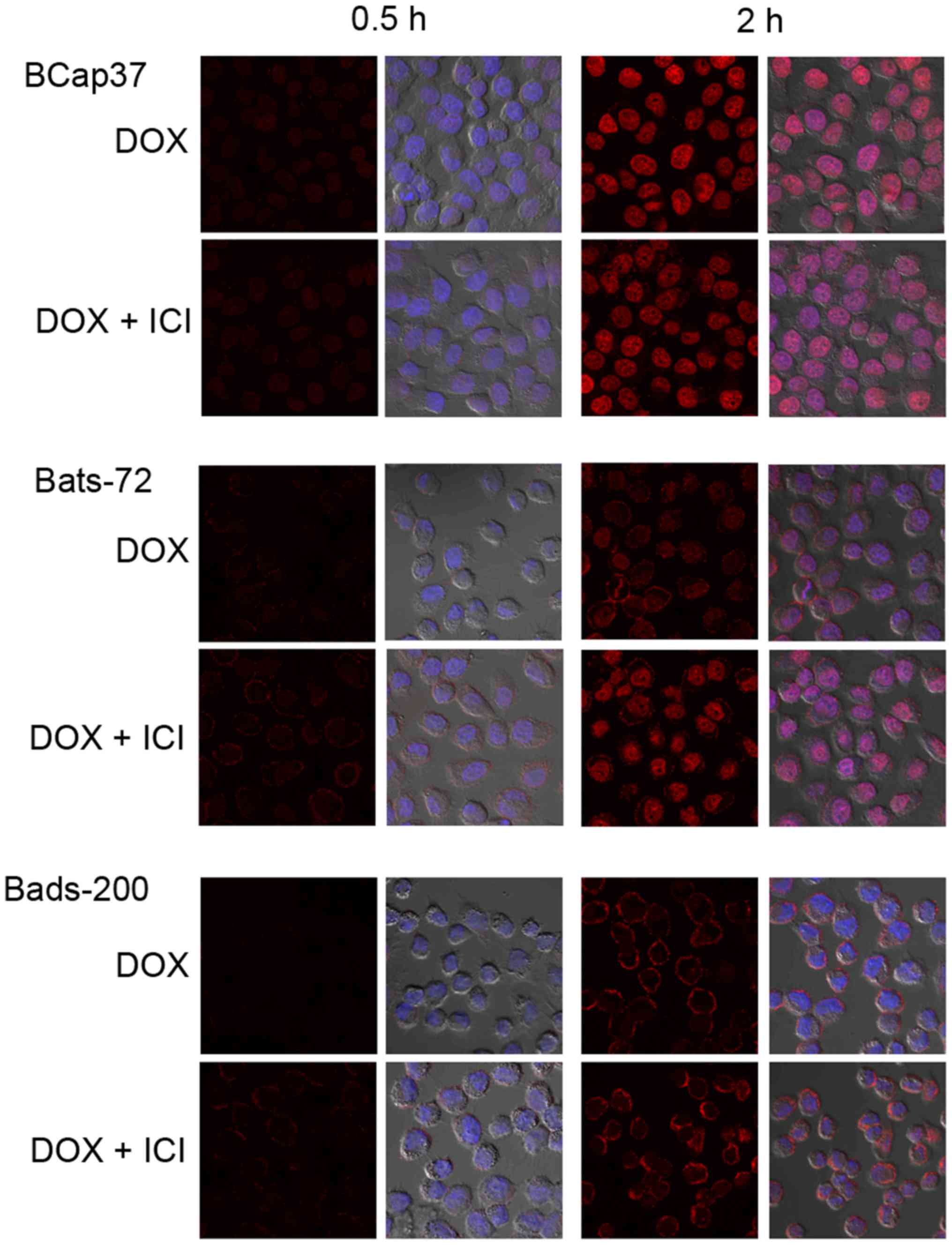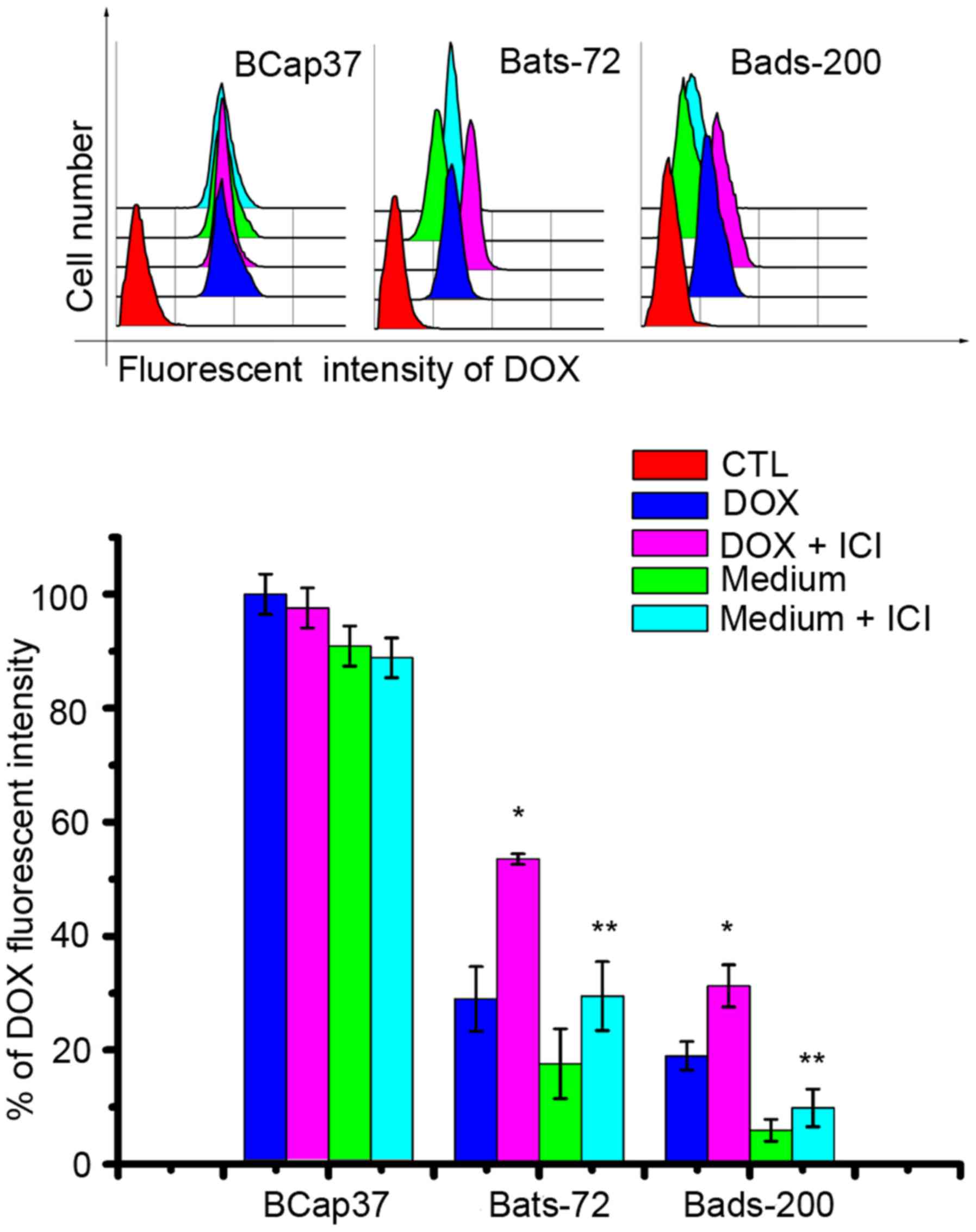Fulvestrant reverses doxorubicin resistance in multidrug-resistant breast cell lines independent of estrogen receptor expression
- Authors:
- Published online on: December 14, 2016 https://doi.org/10.3892/or.2016.5315
- Pages: 705-712
-
Copyright: © Huang et al. This is an open access article distributed under the terms of Creative Commons Attribution License.
Abstract
Introduction
Breast cancer is one of the most common malignancies and a leading cause of cancer-related mortality in women (1). Hormone receptor (HR), especially estrogen receptor (ER), plays important roles in the development and progression of breast cancer (2). There are different therapy choices in clinic according to HR status of breast cancer. The HR-positive sub-type which requires estrogen to grow potentially is susceptible to endocrine therapy that blocks the receptors to improve the prognosis (3,4), while the HR-negative sub-type, mostly relys on traditional chemotherapy. For example, anthracycline and taxanes based regimens are widely used as the first-line scheme (5,6). Although HR-negative breast cancer is sensitive to chemotherapy in initial treatment (7), tumor recurrence frequently occurs (8). In fact, drug resistance is believed to be one of the most common causes of tumor recurrence and is associated with a poor outcome for HR-negative breast cancer patients.
Women with recurrent or metastatic HR-positive breast cancer are appropriate candidates for initial endocrine therapy, and endocrine therapy may be active in patients with negative HR examination, especially in soft tissue disease and/or bone-dominant disease (9–11). Endocrine therapy is also associated with relatively low toxicity. However, to date, endocrine therapy and chemotherapy are recommended to be given sequentially, there is little evidence supporting the combination of endocrine therapy and chemotherapy as the ideal therapy strategy. Fulvestrant (ICI 182,780, Faslodex) is a new type of selective ER downregulator (12–14). It binds, blocks and degrades ER, then inhibits ER-mediated transcriptional activity. Considering that fulvestrant is indicated for patients with disease progression which may imply the development of aquired drug resistance, we wonder whether fulvestrant could further enhance efficacy in combination regimens. Several research groups have reported the rationale and evidence for the efficacy of fulvestrant in combination with other agents such as gefitinib and trastuzumab (15,16).
In our previous studies, we found that the combination of fulvestrant could markedly reverse the ER-mediated resistance and sensitize ER-positive BCap37 cells which were derived from stable transfection of an ER-α expression vector into ER-negative BCap37 cells to antimicrotubule agents such as paclitaxel and vinca alkaloids in vitro and in vivo (17–19). So fulvestrant not only works as endocrine therapy but can also sensitize the efficacy of conventional chemotherapeutic drugs for ER-positive breast cancer. More recently, we successfully established two independent novel paclitaxel-resistant cell lines Bats-72 and Bads-200 from the same parental BCap37 cell line, both of which were ER-negative and showed cross-resistance to other anticancer drugs including doxorubicin (20). Compared to parental BCap37 cells, both Bads-200 and Bats-72 cells overexpress P-glycoprotein (P-gp), which functions as an ATP-dependent efflux pump with a variety of substrates and plays an important role in mediating multidrug resistance (21–23). Interestingly, we found that fulvestrant could significantly reverse the resistance to paclitaxel in Bads-200 and Bats-72 cell lines. In addition, we also found fulvestrant could enhance their sensitivity to many other chemotherapy drugs including docetaxel, vinorelbine and doxorubicin (24).
To further explore this interesting phenomenon, we performed a series of experiments to investigate the combination treatment of fulvestrant and doxorubcin in ER-negative breast cancer cell lines Bads-200 and Bats-72 which may support the feasibility of the combination of fulvestrant and chemotherapeutic drugs for MDR breast cancer in the clinic.
Materials and methods
Cell lines and cell culture
The human breast cancer cell line BCap37, two MDR cell lines Bads-200 and Bats-72, paclitaxel-selected derivative obtained from parental BCap37 cell line (20), the human oral squamous carcinoma cell line KB and and its vincristine-selected derivative KBv200 were cultured in RPMI-1640 medium with 10% fetal bovine serum and 1% penicillin/streptomycin. Bads-200 cells were maintained in medium containing 200 nM paclitaxel (20), and KBv200 were grown in medium added 100 nM vincristine to keep their drug resistance characteristics (25).
Drugs and treatments
Doxorubicin, fulvestrant, verapamil and tamoxifen were purchased from Sigma (St. Louis, MO) for studies in vitro. All chemicals were prepared according to the drug specifications and diluted with culture medium to the desired concentrations before use. All cells were cultured in drug-free medium for more than 24 h before treatments. Then the cells were treated with distinct dose of doxorubicin with or without 3-h pretreatment of fulvestrant.
In vitro cytotoxicity assays
The 3-(4,5-dimethylthiazol-2-yl)-2,5-diphenyltetrazolium bromide (MTT) assay was used to measure the drug-induced cytotoxicity. Briefly, 104 cells/well were seeded and incubated overnight, varying concentrations of designated drugs were added into each well. At the end of drug exposure for 72 h, MTT solution was added and the plates were further incubated for 3 h. Then, the medium was removed and 200 µl of DMSO was added to dissolve the formazan crystals, then individual wells were determined at 570 nm with a microplate reader. The relative fraction of survival was calculated by dividing the absorbance of treated wells by that of the untreated control. Background absorbencies were subtracted, IC50 values represent concentrations causing 50% inhibition of cell growth.
Cell cycle analysis
Cell cycle distributions were assessed by flow cytometric analysis. Cells were incubated in 6-well plates with 105 cells/well. After 48 h of drug treatment, Both floating and adherent cells were collected and washed twice with ice-cold PBS. Following fixation in 70% ethanol diluted in PBS, the fixed cells were washed twice with PBS and treated with 100 µg/ml RNase and 40 µg/ml propidium iodide at room temperature for 0.5–1.0 h in the dark. Cell cycle distribution and DNA content were tested by a Coulter Epics V instrument (Beckman Coulter, Inc., Fullerton, CA, USA) with an argon laser set to excite at 488 nm.
Intracellular doxorubicin distribution and accumulation
Confocal cell images were determined to assess intracelluar doxorubicin distribution and accumulation. Cells were seeded on coverslips in 6-well tissue culture plates and incubated for 48 h to grow as monolayers, then they were treated with or without 5 µM fulvestrant for 2 h before exposure with 5 µM doxorubicin. After washing twice with ice-cold PBS, 10 µg/ml Hoechst-33342 was added into plates for nuclear staining, followed by fixation with 4% paraformaldehyde solution. Finally, air-dried coverslips were mounted on slides with glycerol-PBS (1:1) and imaged using a confocal laser scanning microscope at 600 times magnification.
Quantitation of doxobicin uptake and efflux
Cells were plated into 6-well plates and allowed to grow for 48 h. Then cells were exposed with doxorubicin in the presence or absence of fulvestrant followed by incubation for 2 h. To evaluate doxorubicin efflux, cells treated 2 h with the combination of doxorubicin and fulvestrant were further incubated in drug-free medium with or without fulvestrant for additional 2 h. After washed with ice-cold PBS, intracellular doxorubicin fluorescent intensity (accumulation fluorescence) was determined with Coulter Epics V instrument (Beckman Coulter, Inc.). The cells were excited at 485 nm, and emission was collected at 530 nm for doxorubicin.
ATPase activity assay
P-gp ATPase activity was measured with the Pgp-Glo assay system according to the manufacturer's instructions (Promega, Madison, WI, USA) to identify the impact of fulvestrant on P-gp ATPase activity (26). Fulvestrant (5 µM) or 5 µM doxorubicin were incubated with 5 mM MgATP and 25 µg recombinant human P-gp membranes at 37°C for 40 min. Luminescence was initiated by ATP detection buffer. After 20 min to develop luminescent signals, the multiplate was read on a plate-reading luminometer. The decreased luminescence reflects ATP consumption.
Apoptosis assay
Cells were treated with doxorubicin and fulvestrant alone or in combination for 48 h and the cell morphology was identified using a light microscope at × 400 magnification. Annexin V-FITC staining (Beyotime, Haimen, China) was used to detect cell apoptosis according to the manufacturer's instructions (27). Briefly, after the designated treatment and at the end of time-point, both detached and attached cells were harvested and washed twice with ice-cold PBS. The collected cells were then resuspended with Annexin V binding buffer and incubated with 5 µl of fluorescein isothiocyanate (FITC) Annexin V for 15 min at 4°C in the dark. The percentages of apoptotic cells were determined by flow cytometry.
Western blotting
Cells were treated with doxorubicin and fulvestrant alone or in combination for 24 h. Cellular protein was isolated with a protein extraction buffer (Beyotime). Protein concentrations were measured with the BCA protein assay kit (Pierce). Equal amounts (40 µg/lane) of proteins were fractionated on 10–12% SDS-PAGE gels and transferred to polyvinylidene difluoride membranes. The membranes were incubated with the desired primary antibodies, respectively. After washing with PBS containing 0.1% (v/v) Tween-20, the membranes were incubated with anti-mouse or anti-rabbit IgG coupled to HRP second antibodies for 2 h at room temperature followed by enhanced chemiluminescent staining using the ECL system. β-actin was used for normalization of protein loading.
Statistical analysis
Data are presented as mean ± standard error (SE). Student's t-test was used to determine the statistical difference for two-group comparisons, and multiple-treatment groups were analyzed by one-way ANOVA. Differences were considered statistically significant at a level of P<0.05.
Results
Fulvestrant sensitizes doxorubicin-induced cytotoxicity in ER-negative MDR cell lines
To evaluate the modulation activity of fulvestrant to doxorubicin in ER-negative MDR cell lines, including Bats-72, Bads-200 cell lines and KBv200 cell lines all with MDR phenotype as a result of P-gp overexpression, we examined its intrinsic cytotoxicity. The survival rates of the two MDR cell lines were >90% after exposure to 1–10 µM fulvestrant for 72 h (data not shown) and we chose 5 µM fulvestrant for the following test to evaluate its reversal activity. The sensitivities of the two different MDR cell lines treated with a series of concentrations of doxorubicin in the absence or presence of 5 µM fulvestrant are shown in Fig. 1A and B. The IC50 values of 72-h doxorubicin exposure approximately were 0.11±0.03, 1.91±0.17 and 10.97±3.86 µM respectively. Three-hour-pretreatment with fulvestrant, which alone had no effect on cell viability, significantly sensitized Bats-72 and Bads-200 to doxorubicin in a dose-dependent manner. The IC50 values were decreased to 0.50±0.10 µM in Bats72 and 1.47±0.05 µM in Bads200, respectively. For KB, KBv200 cells, similar results were found, the IC50 value for KBv200 cells was decreased from 2.30±0.9 to 0.20±0.03 µM after treated with doxorubicin alone or in combination with fulvestrant for 72 h (Fig. 1B and Table I). Other doses of fulvestrant were selected to further determine whether the reversal potency is dose-dependent. As Fig. 1C shows, 10 µM fulvestrant produced a more significant reversal effect than 1 µM fulvestrant after Bats72 and Bads200 cells were cotreated with 1 µM doxorubicin, although 1 µM fulvestrant also can enhance doxorubicin-induced cytotoxicity. These data indicated that fulvestrant strongly sensitized doxorubicin-induced cytotoxicity in MDR cell lines.
The reversal activity of Fulvestrant was further compared with the classic P-gp modulators' efficacies, like verapamil and tamoxifen. First the cytotoxicities of verapamil and tamoxifen alone were determined by MTT assay, their concentrations at ≤10 µM exerted slight cytotoxicity on BCap37, Bats-72, Bads-200 cells, and the cell survival rates were >90% (data not shown). Verapamil (5 µM) or tamoxifen were co-treated with serial concentrations of doxorubicin to BCap37, Bats-72, Bads-200 cells, respectively. As shown in Fig. 1A and Table I, verapamil reduced the IC50 values of doxorubicin approximately to 0.17±0.08 and 1.20±0.01 µM in Bats72 and Bads200 cells, respectively, and the IC50 values of doxorubicin in the presence of tamoxifen were 0.86±0.13 and 4.26±0.70 µM in Bats72 and Bads200 cells, respectively. The trend of cell survival curves also showed that the reversal potency of fulvestrant is similar to that of verapamil and is more effective than that of tamoxifen when in combination with doxorubicin at the same doses.
Fulvestrant potentiates doxorubicin-induced apoptosis
To further investigate whether fulvestrant potentiates the cytotoxicity of doxorubicin to induce apoptosis, morphologic analysis was done using a regular light microscope after BCap37, Bats-72, Bads-200 cells treated with doxorubicin and fulvestrant alone or in combination for 48 h. As depicted in Fig. 2, fulvestrant reinforced the degree of doxorubicin-induced cell death in Bats-72 and Bads-200 cells, while treatment with fulvestrant alone showed no change on cellular morphology. Quantification of apoptosis was determined by Annexin V-FITC assay. 5 µM fulvestrant significantly increased the percentage of Annexin V-positive cells after treated with 1 µM or 5 µM doxorubicin in Bats72 cells and Bads200 cells. Interestingly, fulvestrant also increased apoptosis induced by 1 µM doxorubicin in Bcap37 cells and obviously changed their cellular morphology, while there was little difference between treatment with 5 µM doxorubicin in the presence or absence of fulvestrant, both of which induced >90% percentage of Bcap37 cells death, as a result that 5 µM doxorubicin alone killed almost all the Bcap37 cells. The results demonstrate that the apoptosis levels increased with higher doxorubicin concentrations and fulvestrant potentiated doxorubicin-induced apoptotic in the three cell lines.
Fulvestrant enhances doxorubicin-induced G2/M arrest and upregulation of cyclin B1
In previous studies, different levels of doxorubicin dose produced different cell death pathways, and lower doses may induce G2/M arrest (28,29). To investigate whether fulvestrant also enhanced doxorubicin-induced G2/M arrest, cell cycle distribution was analysed by flow cytometric assay (Fig. 3A). After 48-h exposure of 0.1 µM doxorubicin with 3-h pretreatment of 5 µM fulvestrant, the population of cells in G2/M phase in the Bats72 and Bads200 increased markedly compared with that of the doxorubicin treatment alone. Conversely, fulvestrant showed little effect on the cell cycle of BCap37 cells while the majority of BCap37 cells were arrested in G2/M phases with or without fulvestrant.
In order to further elucidate that fulvestrant increased doxorubicin-induced cell cycle arrest at G2/M phase, we examined its modulation on protein levels associated with the G2/M phase of the cell cycle. BCap37, Bats-72 and Bads-200 cells were exposed to 0.1 and 1 µM doxorubicin for 24 h, and then the levels of several protein were detected. Western blotting (Fig. 3B) revealed fulvestrant upregulated cyclin B1 expression following co-treatment with 0.1 µM doxorubicin in Bats-72 cells and both 0.1 and 1 µM doxorubicin in Bads-200 cells, while 0.1 µM doxorubicin resulted in the maximal expression levels of cyclin B1 in BCap37 cells with or without fulvestrant. Cyclin B1 expression seems cell cycle-dependent, the increase in cyclin B1 protein levels was associated with the extent of doxorubicin-induced G2/M arrest in all the three cell lines. Another protein, the cdc25c which is an upstream regulator of cyclin B1 showed no change in protein levels compared with various treatment, further indicating that the doxorubicin-induced G2/M arrest was more likely mediated by the level of cyclin B1. Additionally, we also detected the anti-apoptotic Bcl-2 protein levels which remained constant before and after treatment.
Fulvestrant functions as a substrate for transport by P-gp, without affecting its expression
It has been believed that the change of P-gp expression or its function may influence the efficacy of P-gp-mediated MDR, therefore the relationship between fulvestrant and P-gp was studied. Western blotting (Fig. 3B) showed doxorubicin, fulvestrant alone or in combination did not alter the expression of P-gp. To further determine the interaction between fulvestrant and P-gp which acts as an ATP-dependent efflux pump and relies on ATP hydrolysis, the effect of fulvestrant on P-gp ATPase activity was measured next. As Fig. 4 shows, fulvestrant significantly stimulated the P-gp ATPase activity like doxorubicin which means fulvestrant is a substrate for transport by P-gp. Interestingly, the decrease in luminescence (the average relative light units ∆RLU) of 5 µM fulvestrant-treated samples was approximately 105.17±13.21, which is almost equal to that of 5 µM doxorubicin-treated samples which was 100.73±6.18. These data demonstrate fulvestrant reverses doxorubcin resistance as a substrate of P-gp that inhibits its role of drug-efflux pump.
Fulvestrant alters intracellular doxorubicin distribution, accumulation and retention
Using confocal fluorescent microscopy, we observed the doxorubicin auto-fluorescent intensity to assess the intracellular doxorubicin distribution and accumulation in BCap37, Bats-72 and Bads-200 cells. Fig. 5 indicated that intracellular doxorubicin which increased in a time-dependent manner were mostly accumulated in nuclei of the parental BCap37 cells, but localized both in the nuclei and cytoplasm of Bats-72 and Bads-200 cells. Co-treatment of fulvestrant increased doxorubicin accumulation and relocalized it to the nuclei in Bats-72 and Bads-200 cells. Quantitation of doxorubicin uptake and efflux was measured by flow cytometric analysis. As Fig. 6 illustrates, the doxorubicin uptake was slower but efflux was faster in Bats-72 and Bads-200 cells than in BCap37 cells. Incubation with the addition of fulvestrant increased doxorubicin uptake in Bats-72 (28.97±5.68 versus 53.52±0.94%, P<0.05) and Bads-200 cells (18.99±2.49 versus 31.27±3.68%, P<0.05), and incubation with doxorubicin-free medium for another 2 h after that co-treatment, fulvestrant also can inhibited efflux and increased retention in Bats-72 (17.60±6.14 versus 29.49±6.04%, P<0.05) and Bads-200 cells (5.94±1.93 versus 9.86±3.3%, P<0.05). These findings suggested fulvestrant increased intracellular doxorubicin accumulation and retention and relocalized it to the nuclei in Bats-72 and Bads-200 cells, but had no significant influence in parental BCap37 cells.
Discussion
By a series of cytotoxicity assays in vitro, we found that fulvestrant significantly sensitized doxorubicin-induced cytotoxicity in a dose-dependent manner in ER-negative MDR cell lines including Bats-72, Bads-200 cell lines and KBv200 cells. Direct comparison with known modulators further elucidated that the reversal potency of fulvestrant is similar to that of verapamil and more potent than that of tamoxifen when administered at the same doses in vitro. In addition, compared to other MDR modulators, another prominent feature of fulvestrant is its safety. The concentration of fulvestrant required to achieve a marked reversal has little cytotoxicity by itself. Clinical observations further confirmed this conclusion, fulvestrant which is a pure ER antagonist possesses no agonist effects, while tamoxifen is thought to be a partial estrogen agonist. Estrogen side effects may cause endometrial hyperplasia or cancer, uterine sarcoma, and may increase the risk of deep vein thrombosis and stroke (30–32). Considering the effective and well-tolerated properties, fulvestrant is a promising modulator for the treatment for P-gp-mediated drug resistance.
Cumulative evidence suggests that resistance to cell death programs and cell cycle arrest also contributes to the development of MDR (33–35). Our data indicate that the extent of doxorubicin-induced apoptosis and G2/M arrest is closely related to the potency of drug resistance in BCap37, Bats-72, Bads-200 cell lines. Fulvestrant significantly potentiated doxorubicin-induced apoptosis and G2/M arrest in Bats-72 and Bads-200 cell lines, while it alone did not induce apoptosis or change cell cycle progression, probably representing fulvestrant restored sensitivity to doxorubicin in Bats-72 and Bads-200 cell lines partially through regulation of cell death and cell cycle pathways. The western blot analyses further indicated that the doxorubicin-induced G2/M arrest was more likely mediated by the level of cyclin B1, and fulvestrant enhanced doxorubicin-induced G2/M arrest through upregulation of cyclin B1 expression. It is well known that alterations of the levels of Bcl-2 family proteins play an active role in apoptotic pathways (36,37). It seemed that the levels of the major anti-apoptotic protein Bcl-2 which remained stable with or without doxorubicin did not associate with the sensitivity to doxorubicin-induced apoptosis.
The interaction between fulvestrant and P-gp was further investigated. The ATPase assay showed fulvestrant could stimulate the ATPase activity of P-gp, which means that it acts as a substrate of P-gp to inhibit its function of drug-efflux possibly by competitively binding to P-gp. Western blotting further indicated that fulvestrant did not alter P-gp expression. Therefore, fulvestrant could modulate P-gp mediated resistance mainly by inhibiting its function, and not by inhibiting its expression. On the other hand, fulvestrant increased intracellular doxorubicin accumulation and retention in Bats-72 and Bads-200 cells, but had no significant influence in parental BCap37 cells that lack P-gp, also implied that the reversal of drug resistance by fulvestrant was probably attributable to the inhibition of P-gp-mediated drug transport. Interestingly, we observed that Bats-72 and Bads-200 cells altered intracellular doxorubicin distribution and accumulation compared with parental BCap37 cells. Confocal cell images displayed that intracellular doxorubicin was mostly concentrated in nuclei of the parental BCap37 cells, but localized both in the nuclei and cytoplasm of Bats-72 and Bads-200 cells, especially for Bads-200 cells, the majority of doxorubicin was still in the cytoplasm. Those results suggested that doxorubicin could not easily get access to nuclear targets of MDR cells. Fulvestrant not only restored doxorubicin accumulation but also tried to relocalize it to the nuclei in Bats-72 and Bads-200 cells. The mechanism of doxorubicin activity is thought to interact with DNA by intercalation (38–40), so fulvestrant increased the amount of doxorubicin accessed to nuclear targets in MDR cells, which maybe another potential reason related to its reversal potency to P-gp mediated doxorubicin resistance.
In conclusion, we have shown that fulvestrant significantly reverses P-gp mediated resistance to doxorubcin in vitro. The results suggest that fulvestrant not only takes part in ER-mediated pathway for breast cancer therapy, but also has an important role in the reversal of drug resistance when combined with chemotherapy agents independent of ER expressing. This study may provide useful clues for understanding the novel anticancer mechanism of fulvestrant and supporting the clinical application of fulvestrant when added to chemotherapy regimens for the treatment of metastatic and progressive breast cancer, however, further research is still needed to determine the ideal combination therapy strategy.
Acknowledgements
This study was supported by grants LQ14H160004 from Zhejiang Provincial Natural Science Foundation of China and NSFC-81302288 from National Natural Science Foundation of China.
References
|
Jemal A, Bray F, Center MM, Ferlay J, Ward E and Forman D: Global cancer statistics. CA Cancer J Clin. 61:69–90. 2011. View Article : Google Scholar : PubMed/NCBI | |
|
McGuire WL, Horwitz KB, Pearson OH and Segaloff A: Current status of estrogen and progesterone receptors in breast cancer. Cancer. 39:(Suppl). S2934–S2947. 1977. View Article : Google Scholar | |
|
Dickson RB and Lippman ME: Estrogenic regulation of growth and polypeptide growth factor secretion in human breast carcinoma. Endocr Rev. 8:29–43. 1987. View Article : Google Scholar : PubMed/NCBI | |
|
Kuukasjärvi T, Kononen J, Helin H, Holli K and Isola J: Loss of estrogen receptor in recurrent breast cancer is associated with poor response to endocrine therapy. J Clin Oncol. 14:2584–2589. 1996.PubMed/NCBI | |
|
Lück HJ and Roché H: Weekly paclitaxel: An effective and well-tolerated treatment in patients with advanced breast cancer. Crit Rev Oncol Hematol. 44:(Suppl). S15–S30. 2002. View Article : Google Scholar : PubMed/NCBI | |
|
Sledge GW, Neuberg D, Bernardo P, Ingle JN, Martino S, Rowinsky EK and Wood WC: Phase III trial of doxorubicin, paclitaxel, and the combination of doxorubicin and paclitaxel as front-line chemotherapy for metastatic breast cancer: An intergroup trial (E1193). J Clin Oncol. 21:588–592. 2003. View Article : Google Scholar : PubMed/NCBI | |
|
Andre F and Pusztai L: Molecular classification of breast cancer: Implications for selection of adjuvant chemotherapy. Nat Clin Pract Oncol. 3:621–632. 2006. View Article : Google Scholar : PubMed/NCBI | |
|
Dean M, Fojo T and Bates S: Tumour stem cells and drug resistance. Nat Rev Cancer. 5:275–284. 2005. View Article : Google Scholar : PubMed/NCBI | |
|
Buzdar A, Jonat W, Howell A, Jones SE, Blomqvist C, Vogel CL, Eiermann W, Wolter JM, Azab M, Webster A, et al: Arimidex Study Group: Anastrozole, a potent and selective aromatase inhibitor, versus megestrol acetate in postmenopausal women with advanced breast cancer: Results of overview analysis of two phase III trials. J Clin Oncol. 14:2000–2011. 1996.PubMed/NCBI | |
|
Dombernowsky P, Smith I, Falkson G, Leonard R, Panasci L, Bellmunt J, Bezwoda W, Gardin G, Gudgeon A, Morgan M, et al: Letrozole, a new oral aromatase inhibitor for advanced breast cancer: Double-blind randomized trial showing a dose effect and improved efficacy and tolerability compared with megestrol acetate. J Clin Oncol. 16:453–461. 1998.PubMed/NCBI | |
|
Lønning PE, Bajetta E, Murray R, Tubiana-Hulin M, Eisenberg PD, Mickiewicz E, Celio L, Pitt P, Mita M, Aaronson NK, et al: Activity of exemestane in metastatic breast cancer after failure of nonsteroidal aromatase inhibitors: A phase II trial. J Clin Oncol. 18:2234–2244. 2000.PubMed/NCBI | |
|
Vergote I and Robertson JF: Fulvestrant is an effective and well-tolerated endocrine therapy for postmenopausal women with advanced breast cancer: Results from clinical trials. Br J Cancer. 90:(Suppl 1). S11–S14. 2004. View Article : Google Scholar : PubMed/NCBI | |
|
Dowsett M, Nicholson RI and Pietras RJ: Biological characteristics of the pure antiestrogen fulvestrant: Overcoming endocrine resistance. Breast Cancer Res Treat. 93:(Suppl 1). S11–S18. 2005. View Article : Google Scholar : PubMed/NCBI | |
|
Osborne CK, Wakeling A and Nicholson RI: Fulvestrant: An oestrogen receptor antagonist with a novel mechanism of action. Br J Cancer. 90:(Suppl 1). S2–S6. 2004. View Article : Google Scholar : PubMed/NCBI | |
|
Howell A: The future of fulvestrant (‘Faslodex’). Cancer Treat Rev. 31:(Suppl 2). S26–S33. 2005. View Article : Google Scholar : PubMed/NCBI | |
|
Shen H, Liu J, Wang R, Qian X, Xu R, Xu T, Li Q, Wang L, Shi Z, Zheng J, et al: Fulvestrant increases gefitinib sensitivity in non-small cell lung cancer cells by upregulating let-7c expression. Biomed Pharmacother. 68:307–313. 2014. View Article : Google Scholar : PubMed/NCBI | |
|
Sui M, Huang Y, Park BH, Davidson NE and Fan W: Estrogen receptor alpha mediates breast cancer cell resistance to paclitaxel through inhibition of apoptotic cell death. Cancer Res. 67:5337–5344. 2007. View Article : Google Scholar : PubMed/NCBI | |
|
Sui M, Jiang D, Hinsch C and Fan W: Fulvestrant (ICI 182,780) sensitizes breast cancer cells expressing estrogen receptor alpha to vinblastine and vinorelbine. Breast Cancer Res Treat. 121:335–345. 2010. View Article : Google Scholar : PubMed/NCBI | |
|
Chang J, Sui M and Fan W: Estrogen receptor α attenuates therapeutic efficacy of paclitaxel on breast xenograft tumors. Breast Cancer Res Treat. 134:969–980. 2012. View Article : Google Scholar : PubMed/NCBI | |
|
Jiang D, Sui M, Zhong W, Huang Y and Fan W: Different administration strategies with paclitaxel induce distinct phenotypes of multidrug resistance in breast cancer cells. Cancer Lett. 335:404–411. 2013. View Article : Google Scholar : PubMed/NCBI | |
|
Roepe PD: The P-glycoprotein efflux pump: How does it transport drugs? J Membr Biol. 166:71–73. 1998. View Article : Google Scholar : PubMed/NCBI | |
|
Sauna ZE, Kim IW and Ambudkar SV: Genomics and the mechanism of P-glycoprotein (ABCB1). J Bioenerg Biomembr. 39:481–487. 2007. View Article : Google Scholar : PubMed/NCBI | |
|
Ambudkar SV, Kimchi-Sarfaty C, Sauna ZE and Gottesman MM: P-glycoprotein: from genomics tomechanism. Oncogene. 22:7468–7485. 2003. View Article : Google Scholar : PubMed/NCBI | |
|
Jiang D, Huang Y, Han N, Xu M, Xu L, Zhou L, Wang S and Fan W: Fulvestrant, a selective estrogen receptor down-regulator, sensitizes estrogen receptor negative breast tumors to chemotherapy. Cancer Lett. 346:292–299. 2014. View Article : Google Scholar : PubMed/NCBI | |
|
Zhu X, Sui M and Fan W: In vitro and in vivo characterizations of tetrandrine on the reversal of P-glycoprotein-mediated drug resistance to paclitaxel. Anticancer Res 25B. 1953–1962. 2005. | |
|
Duan Z, Choy E and Hornicek FJ: NSC23925, identified in a high-throughput cell-based screen, reverses multidrug resistance. PLoS One. 4:e74152009. View Article : Google Scholar : PubMed/NCBI | |
|
Ren D, Zhu Q, Li J, Ha T, Wang X and Li Y: Overexpression of angiopoietin-1 reduces doxorubicin-induced apoptosis in cardiomyocytes. J Biomed Res. 26:432–438. 2012. View Article : Google Scholar : PubMed/NCBI | |
|
Rebbaa A, Zheng X, Chou PM and Mirkin BL: Caspase inhibition switches doxorubicin-induced apoptosis to senescence. Oncogene. 22:2805–2811. 2003. View Article : Google Scholar : PubMed/NCBI | |
|
Zuryń A, Litwiniec A, Gackowska L, Pawlik A, Grzanka AA and Grzanka A: Expression of cyclin A, B1 and D1 after induction of cell cycle arrest in the Jurkat cell line exposed to doxorubicin. Cell Biol Int. 36:1129–1135. 2012. View Article : Google Scholar : PubMed/NCBI | |
|
Hu R, Hilakivi-Clarke L and Clarke R: Molecular mechanisms of tamoxifen-associated endometrial cancer (Review). Oncol Lett. 9:1495–1501. 2015.PubMed/NCBI | |
|
Min CR, Kim MJ, Park YJ, Kim HR, Lee SY, Chung KH and Oh SM: Estrogenic effects and their action mechanism of the major active components of party pill drugs. Toxicol Lett. 214:339–347. 2012. View Article : Google Scholar : PubMed/NCBI | |
|
Iqbal J, Ginsburg OM, Wijeratne TD, Howell A, Evans G, Sestak I and Narod SA: Endometrial cancer and venous thromboembolism in women under age 50 who take tamoxifen for prevention of breast cancer: A systematic review. Cancer Treat Rev. 38:318–328. 2012. View Article : Google Scholar : PubMed/NCBI | |
|
Feng R and Dong L: Knockdown of microRNA-127 reverses adriamycin resistance via cell cycle arrest and apoptosis sensitization in adriamycin-resistant human glioma cells. Int J Clin Exp Pathol. 8:6107–6116. 2015.PubMed/NCBI | |
|
Efferth T, Fabry U and Osieka R: Apoptosis and resistance to daunorubicin in human leukemic cells. Leukemia. 11:1180–1186. 1997. View Article : Google Scholar : PubMed/NCBI | |
|
De U, Chun P, Choi WS, Lee BM, Kim ND, Moon HR, Jung JH and Kim HS: A novel anthracene derivative, MHY412, induces apoptosis in doxorubicin-resistant MCF-7/Adr human breast cancer cells through cell cycle arrest and downregulation of P-glycoprotein expression. Int J Oncol. 44:167–176. 2014.PubMed/NCBI | |
|
Kelly PN and Strasser A: The role of Bcl-2 and its pro-survival relatives in tumourigenesis and cancer therapy. Cell Death Differ. 18:1414–1424. 2011. View Article : Google Scholar : PubMed/NCBI | |
|
Llambi F and Green DR: Apoptosis and oncogenesis: Give and take in the BCL-2 family. Curr Opin Genet Dev. 21:12–20. 2011. View Article : Google Scholar : PubMed/NCBI | |
|
Bodley A, Liu LF, Israel M, Seshadri R, Koseki Y, Giuliani FC, Kirschenbaum S, Silber R and Potmesil M: DNA topoisomerase II-mediated interaction of doxorubicin and daunorubicin congeners with DNA. Cancer Res. 49:5969–5978. 1989.PubMed/NCBI | |
|
Cirilli M, Bachechi F, Ughetto G, Colonna FP and Capobianco ML: Interactions between morpholinyl anthracyclines and DNA. The crystal structure of a morpholino doxorubicin bound to d(CGTACG). J Mol Biol. 230:878–889. 1993. View Article : Google Scholar : PubMed/NCBI | |
|
Kellogg GE, Scarsdale JN and Fornari FA Jr: Identification and hydropathic characterization of structural features affecting sequence specificity for doxorubicin intercalation into DNA double-stranded polynucleotides. Nucleic Acids Res. 26:4721–4732. 1998. View Article : Google Scholar : PubMed/NCBI |



